Pilots’ Deep Dive into the World of Turbulence

Recent turbulence incidents have shocked and alarmed travelers. In May, Qatar Airways and Singapore Airlines faced severe turbulence, resulting in injuries among passengers and crew. Tragically, one passenger on a Singapore Airlines flight lost their life.
We interviewed two pilots, one from an EU airline (Pilot B) and one from a non-EU airline (Pilot A), to shed light on turbulence and its impact on flights.
What Do Pilots Think About Turbulence?
How often do you encounter turbulence during flights?
- Pilot A: “I encounter turbulence on most flights, usually light bumps.”
- Pilot B: “The frequency and severity of turbulence depend on the location of operations. It can vary significantly.”
What is the most severe turbulence you have ever experienced?
- Pilot B: “Years ago over Warsaw, we experienced a sudden altitude change of 300 feet in just one second.”
How are pilots trained to handle turbulence?
- Pilot A: “Training covers turbulence detection and prevention techniques during ground lessons. The main focus is maintaining the aircraft’s flight within structural and speed limits.”
- Pilot B: “Training involves identifying turbulence and performing specific actions tailored to different airlines and aircraft types.”
Are there specific regions or altitudes where turbulence is more common?
- Pilot A: “Turbulence types include mechanical, wake, wave, clear air, and frontal. For instance, mountain waves cause turbulence over the Alps, and wake turbulence is common at busy airports.”
- Pilot B: “Turbulence frequently occurs over the Alps, southern regions with high convective action, and near Jetstreams. Airports near mountains often experience mountain waves.”
How has your perspective on turbulence changed over the years?
- Pilot A: “Weather extremes, like abrupt seasonal changes, affect turbulence. This year’s sudden temperature shifts have made turbulence more noticeable.”
- Pilot B: “My perspective hasn’t changed much. Turbulence remains a non-threatening aspect of flying, though climate change may increase its frequency and unpredictability.”
How do weather conditions impact the likelihood of turbulence?
- Pilot A: “Hot days tend to have more turbulence due to unstable air. Seasonal changes, especially extreme temperatures, increase turbulence likelihood.”
- Pilot B: “CB clouds and high temperatures contribute to turbulence. Airports in valleys or near mountains often experience turbulence due to wind patterns.”
What specific maneuvers or procedures do you follow when encountering turbulence?
- Pilot A: “Avoid known turbulence areas if possible. If unavoidable, maintain pre-planned speeds and altitudes based on the turbulence’s intensity.”
- Pilot B: “Secure the cabin, adjust speed to turbulence penetration levels, and use full automation with possible manual adjustments.”
How does training simulate real-life turbulence conditions?
- Pilot A: “Simulators offer realistic experiences for take-offs and landings in turbulent conditions, though they don’t replicate cruising turbulence.”
- Pilot B: “Simulators can’t perfectly mimic real-life turbulence conditions but provide a close approximation.”
How do you ensure the safety of passengers and crew during turbulence?
- Pilot A: “We use seat belt signs and make announcements to ensure passengers are seated and belted. For severe turbulence, we secure the cabin and crew.”
- Pilot B: “We follow cabin secure procedures, take preventive actions, and avoid known turbulence areas.”
What measures are taken to minimize the impact of turbulence on passenger comfort?
- Pilot A: “Avoiding turbulence is preferred for passenger comfort, though it’s not always possible.”
- Pilot B: “Prevention and cabin preparation are key, though safety is prioritized over comfort. Some turbulence cannot be avoided.”
Are there specific features in aircraft that help manage turbulence better?
- Pilot A: “Modern flight controls help reduce turbulence effects.”
- Pilot B: “Seat belt signs and weather radar assist, though radar can’t detect clear air turbulence and only identifies turbulence within clouds.”
How do you use weather forecasts and reports to anticipate turbulence?
- Pilot A: “We plan routes, altitudes, and fuel based on forecasts.”
- Pilot B: “Significant weather charts and pilot reports help identify potential turbulence. Avoidance is preferred if reports indicate turbulence.”
What tools or technologies are available in the cockpit to detect and avoid turbulence?
- Pilot A: “We use pre-flight forecasts, onboard weather radars, and report turbulence to air traffic controllers for further dissemination.”
- Pilot B: “Forecasts, weather radars, and ATC communication help in turbulence detection and avoidance.”
Are there any myths about turbulence you would like to debunk?
- Pilot A: “A common myth is that turning the seatbelt sign on or off affects turbulence. It doesn’t; turbulence remains constant.”
- Pilot B: “Aircraft are designed to withstand severe turbulence. It would take extreme turbulence to cause any damage.”
What advice would you give to passengers anxious about turbulence?
- Pilot A: “Think of turbulence as a minor disturbance. Keep your seatbelt on for safety.”
- Pilot B: “Turbulence is a normal part of flying. Always wear your seatbelt when seated, and trust in the aircraft’s design and safety.”
We appreciate the insights from these pilots. Despite turbulence being a common part of flying, aircraft remain one of the safest modes of travel. For those who encounter disruptions, Travel Compensation can assist you in claiming compensation for canceled, delayed, or overbooked flights.



